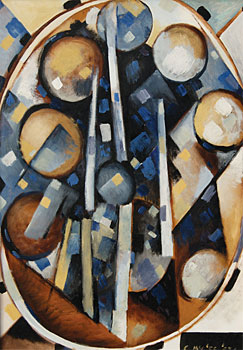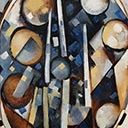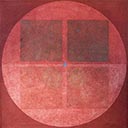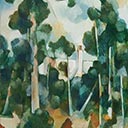Kauri
76 x 55 cm
- This work now sold -
Provenance: Mr Harold Brainsby Collection, Auckland Collection of George Wooller (Estate)
Illustrated: plate 13, p. 99 Colin McCahon: Artist Gordon H Brown A H & A W. Reed Ltd, 1984, revised ed. 1993
p. 188, An Introduction to New Zealand Painting 1839-1967: Gordon H Brown and Hamish Keith, 1969 A H & A W. Reed Ltd, 1984, revised ed. 1993
Exhibited: M.T. Woollaston, Colin McCahon: A Retrospective Exhibition, Auckland City Art Gallery, 1963, no. 85
Record number cm001409 Colin McCahon online catalogue www.mccahon.co.nz
McCahon painted or drew over 50 works with the word 'kauri' in their titles. They are his most extensive open series during the period, from 1953 to 1960, when he lived within a regenerating kauri forest in Titirangi. As a South Islander new to Auckland, McCahon was previously unfamiliar with kauri, a northern species, but it soon came to dominate his attention. He told John Caselberg; 'they are magnificent trees' (quoted in Simpson, Colin McCahon The Titirangi Years 1953-1959, p. 36). McCahon's kauri paintings and drawings are extremely various, ranging in style across the wide spectrum from realist (or 'descriptive' to use his term) at one end to almost completely abstract at the other. If House in the Trees (Lot 36) is at one end of the spectrum, then this Kauri is close to the other. Indeed, would it be even identifiable as a 'kauri' painting if it were not for its title? The closest it comes to being representational are the narrow vertical shapes which may be assumed to depict young kauri trunks. But what are we to make of the circular or spherical shapes which figure so prominently? The only spherical element in the make-up of actual kauri trees is the bright green globular cones.
But it soon becomes apparent that to press too hard on the representational aspect of Kauri is barking up the wrong tree, so to speak. The painting needs to be approached from another direction: from Paul Cézanne and the cubism of Georges Braque. McCahon had discussed Cézanne endlessly in the early 1940s with his friend Toss Woollaston. That he was still a live presence in the Titirangi period is evident from a charcoal drawing of 1953, Madame Cézanne at Titirangi (cm000692), in which the background of the figure (probably a portrait of Anne McCahon) consists of circles and straight lines remarkably similar to this Kauri. Perhaps McCahon was remembering Cézanne's famous words, so influential for Picasso and Braque, 'Treat nature by means of the cylinder, the sphere, the cone…' The cubists abandoned the idea of painting as a window on a piece of reality; rather a painting was a composition into which various elements from reality might be introduced in the construction of a two dimensional picture. Combine this idea with Cézanne's words about the 'cylinder' and 'sphere' and you get close to the pictorial language of Kauri. McCahon has analysed the structure of the kauri tree into its constituent geometrical elements of cylinder (trunk) and sphere (cones and the conical profile of young kauri) reconstituted them within a rectangular panel, and enclosed most of the imagery within a bounding oval line (an idea he picked up from Braque) to pull all the elements together into a satisfying whole - all the while exploiting the principle of contrast which is fundamental to his conception of art. Again the principle comes from Cézanne. McCahon was fond of quoting his statement: 'To paint is to contrast'. Hence the contrast between straight and curved, dark and light throughout this marvellous picture, the surface being vividly animated by the tiny squares and diamonds of colour which are such a feature of the Titirangi period. In his notes for his 1972 Survey catalogue, McCahon said of 1957 paintings such as this, 'I came to grips with the kauri and turned him in all his splendour into a symbol' (A Survey, p. 24). A symbol of what? Perhaps of the life force itself, of what Dylan Thomas called 'the force that through the green fuse drives the flower'. PETER SIMPSON





